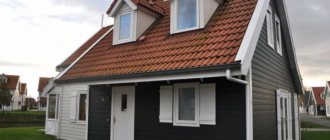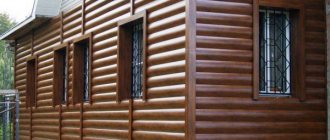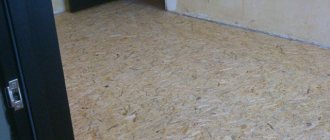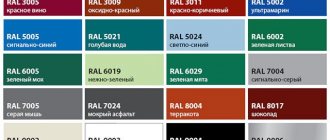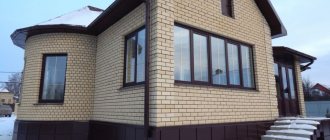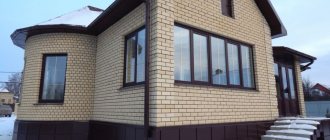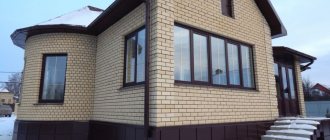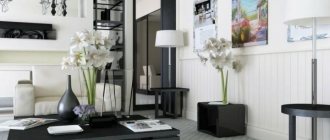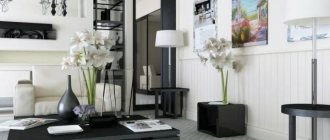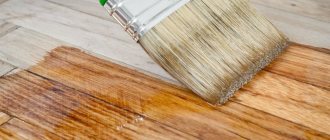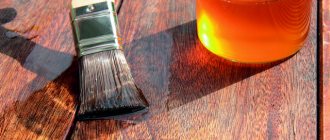A common material chosen for facing work on the facade is siding.
Which material has a large number of varieties, which are characterized by individual properties and advantages.
One of these varieties is fiber cement; it has a significantly lower cost compared to other types and many advantages.
The installation process is not too different from the installation of other varieties, but has some features.
Advantages and disadvantages
Fiber cement siding panels began to be produced in the 20th century. The material contains sand, cement and a certain amount of fibers of synthetic or natural origin. Such fibers are necessary to create a compacting, reinforcing layer, which is obtained after their dissolution in the general composition.
This layer provides high strength and reliability to the panels.
Due to the above joint and the special technologies used for its production, a material is obtained that meets a greater number of requirements regarding performance characteristics.
This material is produced in Germany, the USA, Belgium, Poland, Japan, China and Russia. There are also many different manufacturing companies, which are described in more detail below.
A type of fiber cement siding is used as a finish to give the facade of the house an attractive appearance and at the same time to provide protective functions to the surface of the walls. Wall materials are often destroyed by various weather phenomena, such as hail, rain, ultraviolet rays, wind and snow.
Fiber cement siding has a wide range of colors and textured patterns that are suitable for finishing any type of structure.
You can give your home absolutely any appearance, since the panels are produced with imitation stone, wood or brick. If necessary, such material is supplied for coloring.
Regarding operational properties, the following list of advantages is highlighted::
- the material has a high degree of resistance to any environmental phenomena and serious fluctuations in temperature;
- is not subject to destruction under the influence of chemical or aggressive substances;
- resistant to the appearance and spread of microorganisms, fungi and mold;
- The material is characterized by the absence of deformation even during shrinkage of the house or any other processes. Characterized by compressive and bending strength, maintaining its original dimensions;
- has high fire resistance and is a fireproof material;
- very easy to install and easy to maintain;
- provides the house with a good degree of sound insulation;
- is an environmentally friendly material that does not emit toxic substances into the atmosphere.
Regarding the shortcomings that in some cases you may encounter, there are few of them.
The significant ones are:
- moisture absorption capacity, which is up to 7%;
- the likelihood of the panel changing its shape due to exposure to moisture (2%).
NOTE!
Such shortcomings can be avoided by purchasing material from reliable and reputable manufacturers who produce high-quality fiber cement siding.
Scope of application of fiber cement siding
Fiber cement siding is used for cladding the facades of public buildings and private houses, both “mono” and in combination with other materials. The weight of the panel with the subsystem is around 20 kg/m², but almost any foundation (frame, timber, aerated concrete, etc.) can withstand such a load. For the most part, fiber siding is used as a finishing cladding screen in suspended ventilated systems that include a layer of thermal insulation. However, it can also be used independently when everything is in order with the heating equipment of the building, but the appearance needs improvement.
In addition, some designers use fiber cement boards when decorating interiors, for example, in areas where overheat-resistant cladding or a non-trivial approach to design is needed. Another original option is as a filler in combined fences to support the overall style. In terms of technical and operational characteristics, fiber cement panels are not inferior to specific materials, and in terms of practicality they are superior to many.
Specifications
As for the technical characteristics, they depend directly on the specific brand of the manufacturer.
But, for the most part, the technical characteristics include the following:
- the length of the panels is 3600 mm ;
- 1.86 meters wide ;
- thickness reaches up to 1.2 cm ;
- the bending strength parameter is 24 MPa ;
- the number of cycles that the material is capable of withstanding at low threshold temperatures is 150;
- percentage of water absorption – 20;
- flammability group – G1 ;
- the weight of one panel is 12.2 kilograms .
Here you can see a comparative description of Japanese fiber cement siding, and below we will look at domestic and European manufacturers.
Finishing of facing material
Coating fiber cement siding with acrylic paint
This procedure is carried out to give the finish additional protective properties or the desired color. This should be done after installation, as the slabs may be scratched during this process. For adherents of a natural shade, it is better to choose a colorless varnish.
The paint chosen is acrylic, as it has the most optimal performance characteristics. Application of the compositions is carried out with a sprayer, roller, brush with gripping the end parts. Several layers are made with the necessary time intervals for drying.
Siding Kedral
This company produces siding panels that have a beautiful decorative appearance, have deep relief and are able to imitate a variety of natural materials, such as brick, stone, metal and glass.
Such panels provide a high level of protection for the entire structure . It is also possible to carry out facing work using these panels indoors. Kedral siding is mainly used to imitate brickwork on the surface of facades.
Installation work is permitted in any weather conditions, regardless of the time of year. The service life of the material is 2 times longer than that of natural stone . The material is characterized by an increased level of strength and elasticity, and is not subject to rotting, combustion, moisture or corrosion processes.
It is also not afraid of insects, scratches and any kind of minor mechanical damage.
Photo of Kedral fiber cement siding:
“Samizdat” or professional performance?
Although fiber cement siding can be installed yourself, the process is more complicated than using vinyl or even metal. This is due to both the solid weight of the panels and the peculiarities of their processing - not every home craftsman has a professional tool in his arsenal, and it is not practical to purchase an expensive unit for just one installation. When we are talking about large cottages and complex architecture, to work at height you will also need scaffolding or tours, which are also not an item for general consumption. Another important factor is time costs; a team of professional installers can handle it in a matter of days, whereas with one helmet the process will take weeks. But the most important thing is that even such a wonderful material as fiber cement siding can be “screwed up” due to errors made during installation. This includes unsuitable saw equipment, cement dust not removed from the surface in time after drilling or sawing, working with wet material, and much more.
But you need to hire specialists who have sufficient experience and the appropriate tool base, and not “generalists” who yesterday were digging a trench for the foundation, today they are trying to lay tiles, and tomorrow they are ready to install fiber siding. Such figures will do much more harm than good, since they do not care about the reputation of the manufacturer, and accordingly, they do not bother with the quality of work, and, of course, do not give any guarantees. In order not to waste time searching for performers, we advise you to contact the FRONTMASTER company. All teams have been trained by fiber cement siding manufacturers, which is confirmed by certificates. Plus, the work performed has a two-year guarantee, which only proves the confidence of the craftsmen in their abilities.
Siding Rospan
The siding company produces products similar to Japanese ceramic products. The panels are available in dimensions 1593 X 455 X 14 mm. This siding is characterized by a three-layer coating, for which the warranty stated by the company is 10 years . This layer is represented by acrylate-adhesive paint and a transparent silicone layer.
Depending on the textured pattern, the depth of the relief can reach 4 mm. Considering that the production uses drying and molding under high pressure, the end result is a material that fully imitates natural stone. The panels remain in their original form even under conditions of high humidity (95%) and temperatures from -50 to + 50.
The degree of water absorption generally does not exceed 16%; the material is not characterized by swelling in thickness and deformation . If the low temperature regime is maintained for 50 cycles or more, then the level of bending strength decreases by no more than 10%.
The pressure that the panel can withstand is 45-65 megapascals. The material is characterized by fire-fighting properties, it is difficult to ignite, and does not support combustion.
Using siding produced by Rospan, it is possible to solve the following list of problems:
- with its help, financial costs for external finishing are reduced, in comparison with the use of Japanese-made panels;
- costs are also reduced for working hours, since the required number of work cycles is reduced;
- thanks to the material, the thermal conductivity of the walls of the house is reduced;
- the level of load on the supporting elements of the structure and foundation is reduced in comparison with other options for finishing work, insulation and decoration measures;
- The lifespan of the facade increases, and there is no need to resort to additional maintenance and periodic restoration.
Tools and materials
To install siding, a standard set of household tools is sufficient.
To work you will need:
- perforator;
- Bulgarian;
- jigsaw;
- roulette;
- hammer;
- level;
- screwdriver;
- paint brush.
List of materials:
- panels in calculated quantity;
- additional elements;
- spacer tapes;
- protective paint;
- sealant;
- galvanized roofing nails.
Since it will have to be fastened at heights, you need to take care of a stable ladder. Work must be carried out wearing protective equipment - a helmet, respirator, goggles and gloves.
Siding Latonite
This siding is produced in Switzerland, Austria and Germany. For production, autoclaving and pressing technology is used . This makes it possible to achieve an increased level of strength and density of the slab structure.
This is a fairly practical material for use in finishing work. The texture of the produced panels is varied, it can be smooth or have a relief that imitates brick material, natural stone or logs. It has all the necessary properties to ensure reliable protection of the facade . It can be painted in various colors, and it is also possible to order custom-sized panels.
IMPORTANT!
This siding must be painted where it is cut to maintain its durability.
Types and methods of docking
Most fiber cement siding is installed in a herringbone pattern, with one board covering the other. This is how houses are usually clad with clapboards. The main advantage of this method is the minimal possibility of water flowing between the boards. The moisture simply flows down, since the boards overlap each other by 25-30 mm (depending on the size of the board). But at the same time there is an increased consumption, since with a width of 19 cm, only 15-16 cm remains “working”.
Different installation methods - overlapping and butt
The second type of joining of fiber cement siding boards is end-to-end. It was implemented by the Belgian company Cedral in the “click” series. The board of this series has a quarter cut, is inserted into one another, and is fastened with self-tapping screws to clamps (small mounting plates for hidden fastening). In this case, there is no need to drill the surface of the board, since the tongue of the clamp clings to the protrusion of the board and thus holds it.
Corner without additional elements
The corners and joints of fiber cement siding can be decorated with additional elements - corners; they can be joined by sawing the boards at an angle of 45° and coating the cut with paint. A jar of paint used to paint your material is issued/purchased with the siding batch. Japanese façade fiber cement panels are coated not with paint, but with a recommended sealant. By the way, the sections under the additional elements should also be painted over. The mounting holes are also coated with the appropriate agent.
The corners are finished with special elements
If you like the design with corner finishing, but don’t like the price of these same corners (much more expensive), there is an option - saw the same board lengthwise (of the same or a different color), paint the cut and connect them at the corner with self-tapping screws. It is clear that upon closer examination this option will lose in aesthetics, but if the budget is limited, this is a good way to save money.
Installation of sheathing
installation process is represented by the following steps :
- initially, using self-tapping screws, a film of waterproofing material is attached to the wall of the house;
- After this, the frame is installed on top of the waterproofing layer. For this, wooden blocks are used, the cross-section of which is 5 x 5 mm ;
- If the surface of the building requires insulation measures, then insulation boards are inserted between the sheathing beams, which are pre-cut to the required size. In this case, it is necessary to maintain a certain thickness of the insulating material, which should not be greater than the thickness of the beams ;
- after laying the insulation material, attach the second layer of waterproofing;
- then begin the installation of vertical sheathing, which will serve as the basis for installing siding panels;
- wooden beams are screwed to a frame containing insulating material. This allows you to create a ventilated façade;
- the second row of sheathing can be constructed from wooden blanks, the thickness of which should be at least 3 cm. As a result, the thickness of the entire cladding will be 15 cm .
In the case of vertical attachment of siding, the frame is mounted in a horizontal position. It is also necessary to build jumpers between the main posts . It is recommended to adhere to a step in the process of arranging the frame equal to 40 cm.
Features of installation of fiber cement siding
Regardless of the manufacturer, both wider panels and narrow boards are mounted in the same way - on a wooden or metal subsystem, which must meet certain requirements.
- Wooden - a dry block with a cross-section of at least 40 mm, optimally 50 mm; in the area where two boards join, the width of the block should be at least 70 mm. Before assembling the subsystem, it is advisable to treat the wood with antiseptic impregnations.
- Metal - profile width 40 mm, use as profile guides for drywall is not allowed, metal thickness must be from 0.9 mm.
For both vertical and horizontal orientation of the guides, the step between them should not exceed 600 mm for a wooden subsystem and 500 mm for a metal one. The panels are installed in two ways:
- Overlap (American, herringbone) - this method is used to install the Cedral LAP series and Decover.
- End-to-end – The cover can also be mounted end-to-end; Nitiha produces panels for end-to-end installation with subsequent sealing of vertical seams with a specialized compound. Seamless panels and dry assembly without sealing only in the FUGE and COOL series.
The method of fixation and type of fastener depend on the installation method and manufacturer:
- when assembling with an overlap, nails and stainless steel screws are used (Kedral and Decover);
- when assembling end-to-end in a hidden way (Nitikha and Kedral) - clasps;
- when assembling end-to-end using the open method (Nitikha, W series and Decover) - nails (painted) screws (stainless, painted).
It is worth noting that Kedral does not require pre-drilling when installing with an overlap; it is enough to use self-tapping screws, and it is recommended to pre-drill Decover. And in Nitikha’s instructions only painted nails and screws appear.
Installation of slabs
To carry out cladding work using siding panels, it is necessary to use special fittings - clamps. Such fasteners are commercially available and are included with the purchased material .
Each type of siding requires the use of clamps specialized in size and strength level. If there is no desire to use such accessories, then the siding is fastened with stainless steel self-tapping screws.
The siding installation process is as follows :
- begin the process by attaching the starting strips. They are installed on vertical wooden posts using screws. If the panels are installed in a horizontal position, then the starting racks must also be mounted horizontally . The first plank is installed from the very bottom of the wall surface. This moment is quite important, since the attached first planks are responsible for the further position of the slabs. It is necessary to install as accurately and evenly as possible; for this it is better to use a level, taking measurements first;
- The next step is to install the corner profiles. They are mounted on the edge of the walls and act as guides . Such fittings must be attached to a wooden frame using self-tapping screws;
- The connecting profiles are attached to the constructed frame, and the step should not exceed 1 m. The panels can be installed using various layouts . There is a straight or chess layout;
- To carry out the process of cutting panels, it is necessary to measure the distance from one vertical corner profile to another. The resulting parameter is the width to which the panels must be cut ;
- After cutting, they begin to install the first panel, the location and direction of which will be the starting strip. The entire installation process starts from the bottom of the wall to the top. The panels must be overlapped; installation of the material to the wooden frame is carried out using clamps or by drilling and fastening with screws . It is necessary to drive the fasteners into the surface of the siding panel. It is better to use a screwdriver for this. The head of the screw must be recessed into the product, since after this, the surface of the screws is coated with a special compound to prevent the appearance of corrosive processors;
- The distance for the next siding panel is measured in the same way. Cutting and fastening are carried out by analogy . The junction of two siding elements is protected with a waterproofing film, which is applied to vertically located posts;
- the rest of the process of installing the cladding product is carried out in the same way, installing siding elements one above the other, observing the overlapping installation. The joints are covered with waterproofing material ;
- installation of the finishing strip is an exception to the entire process. Attachment is carried out using clamps if there was no need to cut it. If the finishing strip has been cut, then fixation must be carried out using mushroom-shaped screws , which must first be painted in the appropriate color.
NOTE!
The process of cutting material is best done from the reverse side. This is explained by the fact that after cutting off part of the material, the edges may chip or become jagged.
In addition to the above measures, the installation process requires compliance with several points:
- fasteners must be hidden after the panels are installed. To do this, they resort to using a corrective dye that matches the color of the product. For cladding, it is recommended to purchase this dye immediately with the material. In the case of using clamps, there is no need to mask the fasteners, since they are hidden under the surface of the panels;
- After cutting the material, it is necessary to paint the areas where the product is cut. A good option for such purposes is retouching dye. Using a small brush, paint over all cut areas and any resulting chips;
- It is necessary to ensure the tightness of all seams and gaps. It is undesirable to use silicone material for this; it is best to carry out such an event using colored sealant . This will create a harmonious appearance of the entire tiled surface.
Tool base and nuances of working with fiber cement siding
To install fiber cement panels you will need a certain set of tools.
- To maintain the plane, use hand-held devices such as a construction and hydraulic level and a tap (colored cord) or a laser level designed for outdoor work.
- For processing, you can use a jigsaw with a carbide saw, turning off the pendulum mode, you can use a grinder with a diamond blade, but it is best to cut fiber panels with a miter saw with a broach, equipped with a special disk for sawing cement. It is advisable to process the cut with medium-grain sandpaper to remove burrs, but if the tool is professional, there are usually no burrs left. For drilling, it is necessary to use drills with carbide tips, sharpened at an angle of 60˚.
- For finishing purposes, the sawn ends do not pose any danger to the operation of the fiber siding, but from an aesthetic point of view it is better to paint over them. But not with the first enamel you come across, but with a specialized paint, which is usually included in the line of each manufacturer. It is also useful for touching up the heads of self-tapping screws that remain visible and eliminating possible damage to the paint layer on the panels. All operations should be carried out not on the knee, but on a stable, flat surface.
The main “danger” for fiber siding is cement dust remaining on the surface during sawing and drilling. If the tool is not equipped with a construction vacuum cleaner, it should be removed immediately with a dry soft cloth.
If installation technology is followed and the appropriate tools are used, a facade made of fiber cement siding will last for decades without the need for alteration. But if you don’t have confidence in your abilities, there is a large volume, height or complex architecture, it’s better not to take risks and turn to the professionals from FRONTMASTER.
Subscribe to our Telegram channelExclusive posts every week
General information
At first it was made from asbestos fabric. It had huge advantages - durability, fire safety, it was very difficult to tear. This technology came from Austria. But later they began to produce it using new technology. This fiber cement is not inferior in quality to what was previously available. But it has a huge positive quality in that it is environmentally friendly and does not emit any harmful substances.
In fact, modern fiber cement is a material made from paper fibers filled with minerals and cement. The paper is compacted using a special technology and coated with a special impregnation. It turns out that paper fibers add elasticity, prevent bends and tears and act as reinforcement for already manufactured material, and the presence of cement in the composition adds qualities such as strength and a high level of resistance to heavy loads.
In the future, fiber cement panels will be cut either to standard measurements or according to the buyer’s order. Visually, they can differ significantly, since there are many colors - plain, colored, imitation wood or fiber cement siding to look like stone. The texture can also be smooth or ribbed.
Manufacturers
Fiber cement siding is firmly winning first place in sales rankings in the CIS countries, its popularity is rapidly gaining momentum. Therefore, the production of fiber panels is widespread both in our country and abroad.
The highest quality types of fiber cement siding are offered by Japanese and Belgian manufacturers, however, Russian factories also provide quite competitive products. Among domestic ones, you should pay attention to “Rospan” and “Latonit”.
Rospan produces fiber panels using Japanese technology, thus providing a high-quality and inexpensive analogue of imported finishing. These panels are most often presented in imitation stone, brick, precious wood in several shades.
"Latonit" is a domestic company with an ever-expanding product range. Its production is equipped with the latest European equipment, which allows it to produce fiber cement siding of excellent quality that meets quality standards. "Latonit" has the ability to produce various types of fiber siding.
Pressed, autoclaved - they are suitable for operating conditions at elevated temperatures and exposure to ultraviolet radiation. It is also possible to produce unpressed, autoclaved panels and siding with a surface painted and exposed to ultraviolet varnish.
Nichiha. Excellent quality fiber cement siding is offered by the Japanese company Nichiha. The composition of its products, in addition to cellulose and cement, also includes quartz and mica, which give the panels fire-resistant and additional strength properties. The paint layer is applied repeatedly, which also provides additional hardening of the coating and its durability.
"Mirko" . Another company worth paying attention to when choosing fiber cement siding is Mirko. Here, our own production is used at full capacity, and panels from European and Asian manufacturers are supplied. Mirko provides a wide range of siding for various purposes, that is, made using different technologies - pressed or pressless, autoclaved, and so on.
Cedral . Well, and perhaps the most famous brand of fiber cement siding is Cedral.
This is a fiberboard that exactly imitates natural wood. Kedral fiber cement siding is of excellent quality and is suitable for finishing the facades of buildings and structures for a wide variety of purposes. It can be used in any climate zone, is damage resistant and durable.
Metal siding: types, colors, installation, advantages
Aluminum siding: application features, advantages and disadvantages
Materials used in the production of fiber cement siding
Fiber cement is a composite composition that does not contain asbestos or chlorine. formaldehyde and other dangerous compounds (if these are products from trusted companies). As a rule, more than two-thirds of the total volume is occupied by cement, which holds the remaining components together and gives the finished products strength. About 15-20% is filled with reinforcing fiber.
Natural wood fiber can be used as filler. This is how siding is produced, in particular, by the Japanese company NICHIHA, a world leader in the fiber cement finishing market. Pulp-wood pulp gives the materials rigidity and high bending resistance. Fiber prevents mechanical and temperature deformation and reinforces the siding.
Cellulose fiber is also used by another well-known company from Japan, KMEW, as well as Konoshima and a number of other companies that produce porous boards using the extrusion method. Finished siding, thanks to internal micro-cavities, weighs less than “solid” siding. The remaining share in the volume of fiber cement is occupied by additives:
- mica, quartz, sand, mineral fillers;
- purified water;
- fire retardants that give the siding fire-fighting and self-extinguishing properties, additives that increase ductility, elasticity, etc.
Fiber cement is coated with compounds to protect the outer surface of the siding from damage. Each company has its own, often patented. Thus, Cedral applies water-dispersed acrylate to the panels on the front side, NICHIHA uses complex processing, after which the top coating becomes similar in characteristics to durable ceramics.
How to calculate the amount of materials needed?
To calculate how many panels will be needed for the facade, you first need to measure the height and length of each wall. Based on this, the area of each side is calculated in total with other planes.
Facade decorated with fiber cement siding
As a result, 10% (losses) is added to the total area and a little more for possible repairs.
If you need a more accurate figure for the amount of fiber cement siding and its cost, you can contact the experts at AVI. Managers will make a preliminary free estimate and, if necessary, schedule a surveyor to visit the site.
